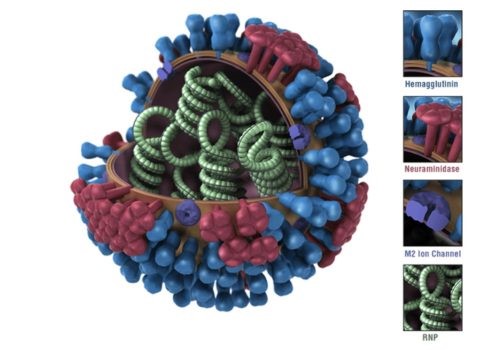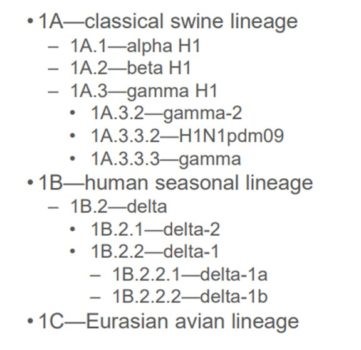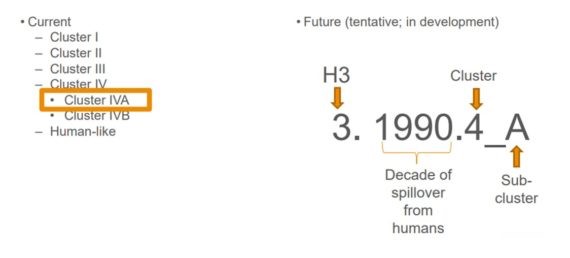Defining Influenza – A Work in Progress

Pigs have historically been considered “mixing vessels” of influenza A viruses (IAV) due to their susceptibility to infection with swine-origin, human-origin and avian-origin IAV, says Micah Jansen, DVM, veterinary manager of US Pork for Zoetis. Pigs also have a propensity to generate reassortant viruses that emerge when different influenza viruses exchange viral RNA gene segments, she tells Pig Health Today.
“With the increasing number of novel subtypes and genetic variants, the control of IAV has become increasingly difficult, and innovative strategies to combat this economically important zoonotic disease are critical,” writes Amy Vincent, a research veterinary medical officer with USDA in an article for “Advances in Virus Research.”
Universal identification needed
Historically, flu viruses were known by their colloquial names: alphas, betas, gammas and deltas, Jansen explains.
“These names are used only in the US, however, because what is circulating here is much different from what other countries see.”
That’s a big reason why a global nomenclature for IAV in swine is necessary, she adds, noting a better system will help practitioners track what influenza is doing and how it’s changing. It will also help veterinarians select the best influenza vaccine for the herd.
Defining the virus
Influenza A viruses are divided into subtypes based on two proteins on the surface of the virus: hemagglutinin (H) and neuraminidase (N), as shown in Figure 1.

Source: Centers for Disease Control and Prevention
“Now let’s take a closer look at how flu viruses are named,” Jansen says. “In the H1 example shown in Figure 2, the first ‘1’ refers specifically to an H1 virus, compared to an H2 or H3 virus. The letter represents the lineage, of which there are three: swine (A), human (B) and avian (C).

Figure 2. Anatomy of an H1 strain designation; Source: Zoetis
“The next number is the clade, which would refer to whether the virus is an alpha (1), beta (2), gamma (3) or delta (4),” she continues. “Then, there are more differentiating factors with subclades and subdivisions. These new designations have come out of necessity because the virus continues to change. Figure 3 shows an example of the global nomenclature for H1.”

Figure 3. Global nomenclature for H1; Source: Zoetis
The list shows how the strains are differentiated:
The pandemic strain of 2009 (H1N1pdm09) listed in Figure 3 changed enough to warrant its own designation, Jansen says. Conversely, 1A.3.3.3 is now a classically circulating gamma, and pandemic is a 1A.3.3.2.
“The designation shows they are related but have changed enough that we would not expect a high-level of cross-protection,” she says.

Figure 4. Delta strain designation; Source: Zoetis
In Figure 4, the deltas show differences all the way through the subdivision, Jansen points out. This illustrates the grouping of strains that are different enough to have their own designation.

Figure 5. Nomenclature for H3; Source: Zoetis
Compared to the nomenclature for H1, the H3 nomenclature is different, Jansen says.
“There is still a hemagglutinin designation, indicating that it is an H3 virus, not an H1. Remember, no H3 was circulating in pigs until the virus started spilling over from humans, so the designation shown immediately after H3 indicates the decade in which the virus spilled over from humans,” she explains. “For the example in Figure 5, on the left side is the colloquial name, Cluster IVA. Looking at the proposed global nomenclature, one can see it’s an H3 virus; 1990 shows it is a part of the family that spilled over from humans in the late 1990s. There are various clusters and sub-clusters of the virus that exist as well, which are listed following the spillover-decade designation.”
Triple-reassortant
A virus containing genes from avian, human and swine influenza viruses is called a triple-reassortant virus, Jansen says. It emerged in the late 1990s in North America and led to reassortment with the classical viruses. It subsequently gave rise to antigenically distinct H3N2, H1N1 and H1N2 strains.
“The triple-reassortant internal gene (TRIG) constellation became the predominant backbone of the viruses circulating in pigs in the US,” Jansen says. “Shortly thereafter, two additional introductions of human-origin H1N1 resulted in the establishment of two new lineages of H1N1 and H1N2 viruses after reassortment with the TRIG strains, termed delta lineages.”
For reassortment to occur, these viruses have to be in the same cell.
“What is probably underrecognized is how frequently co-infection of multiple influenza viruses occurs, not only within the same population but within the same pig and within the same cell,” Jansen notes.
More knowledge for practitioners
The purpose of the defined nomenclature is to arm practitioners with more knowledge to make better decisions, Jansen points out.
“The key question that the practitioner needs to answer is: Will the vaccine that I’m using provide cross-protection? Practitioners and producers need to know if the virus within their system is changing or if there was a new introduction. Or, they need to know whether a reassortment occurred that is now showing up as a new virus,” she says.
“Practitioners are paying attention to the nomenclature when they get a report back from the diagnostic laboratory to help them quickly assess whether the strain is new or if it already exists in the herd,” Jansen continues. “The information in the report helps them look at new strategies to better control IAV-S and look for ways to provide cross-protection. Not all diagnostic lab reports have included that information, but they’re improving.”
Flu viruses will continue to change and practitioners will want to know sooner rather than later if a new strain is circulating in their clients’ herds. Using the new nomenclature will help them gain a better understanding of influenza and will help them identify and track differences in their clients’ herds. The combination of these factors will enhance practitioners’ ability to control influenza with improved strategies, Jansen says.
More from Farm Journal's PORK:
Piecing the Puzzle Together: Diagnostic Monitoring and Flu Prevention
Veterinarians Answer Questions on Influenza
Farm Factors Influencing Influenza A Virus Infection In Weaner Pigs







